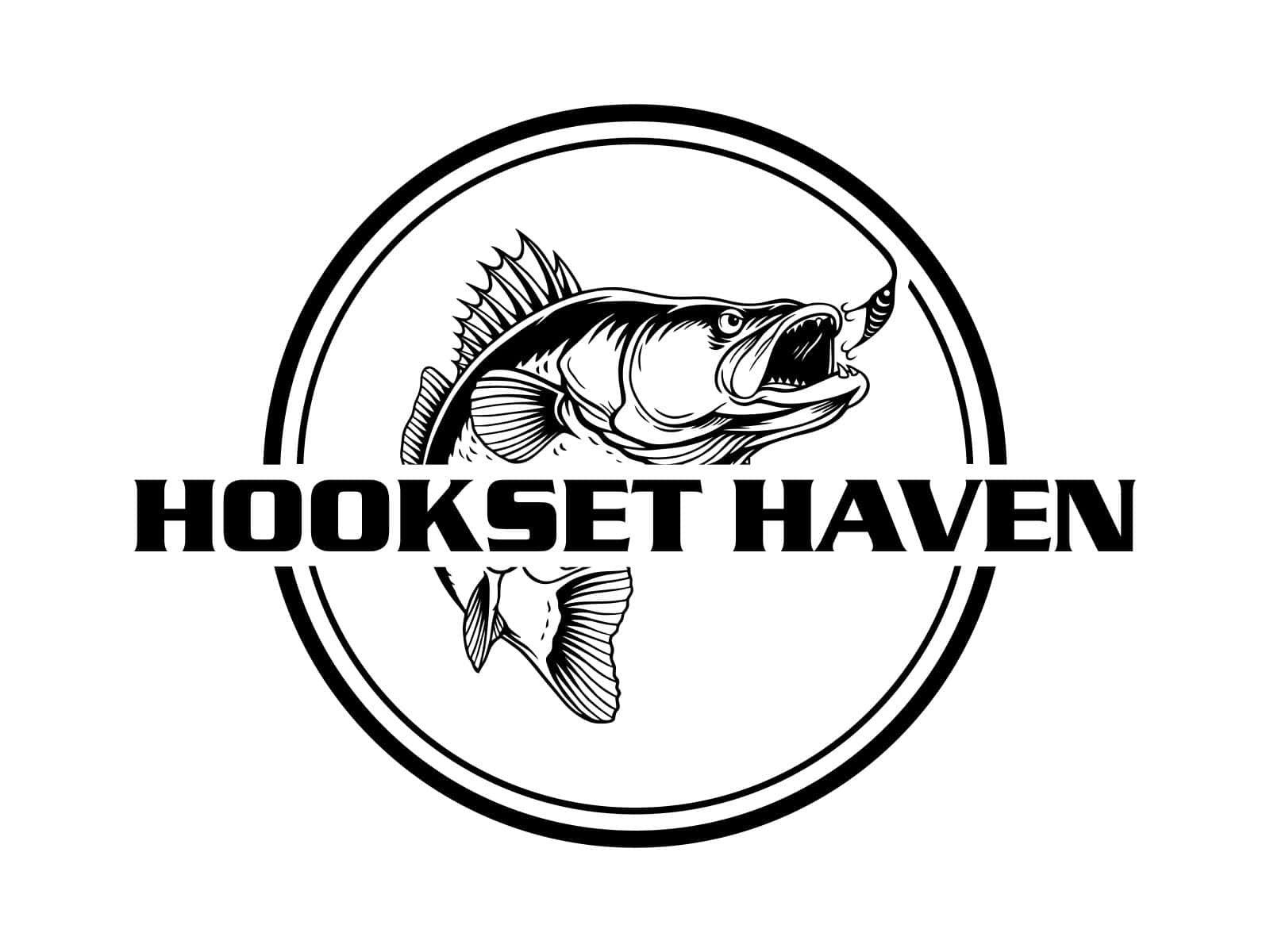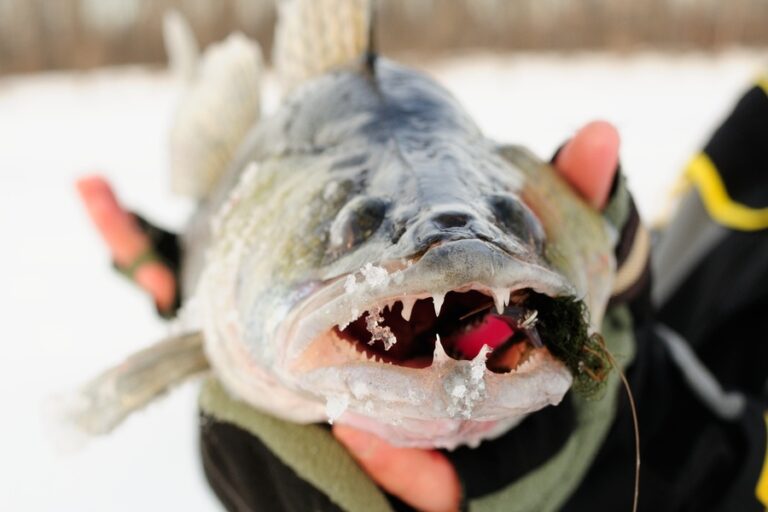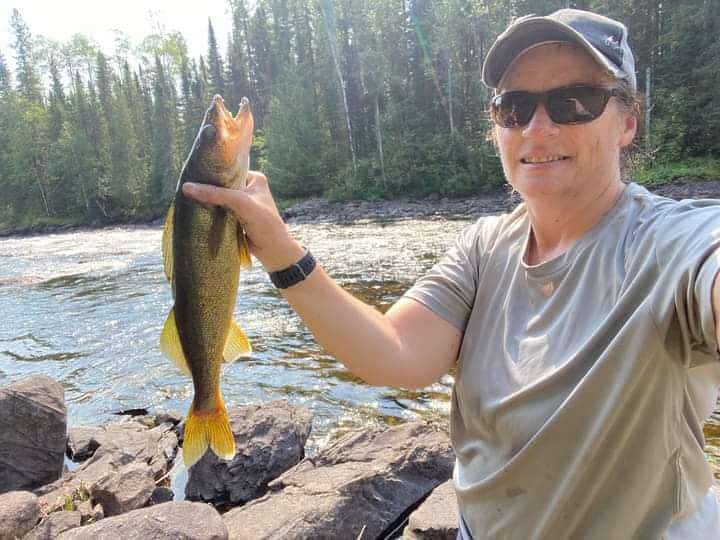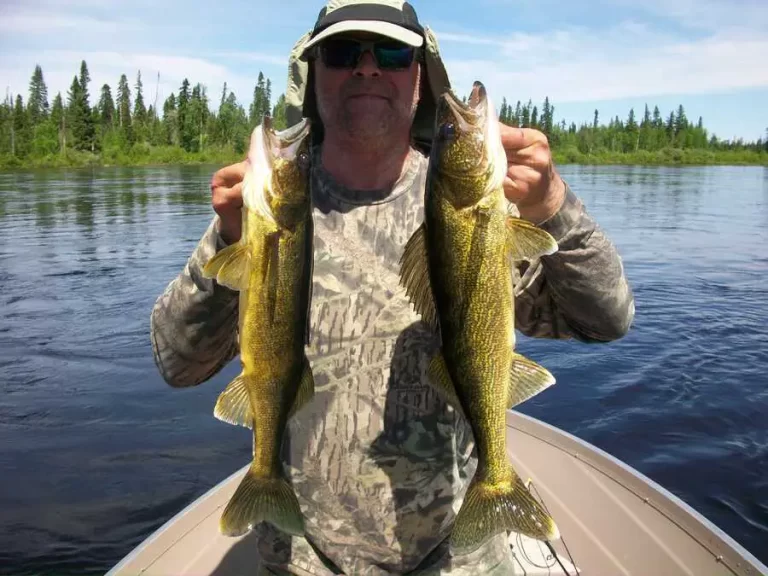Walleye Fishing in Arizona (Best Lakes & Rivers) Full Guide
With its diverse range of lakes and rivers, Arizona offers some surprisingly good opportunities for walleye. Although not a native Arizona fish species, walleye stocked in the state thrive and provide an awesome fishing opportunity.
The best walleye fishing in Arizona can be found in larger lakes such as Lake Powell, Roosevelt Lake, and Show Low Lake. The deep, cool waters provide great habitat for walleye, especially during the best fishing seasons of spring and fall.
I worked seasonally in Arizona on a fisheries crew doing various studies and projects around habitat improvements, creel surveys, and field sampling. Additionally, I have fished around the state for walleye including booking two fishing charters with top guides.
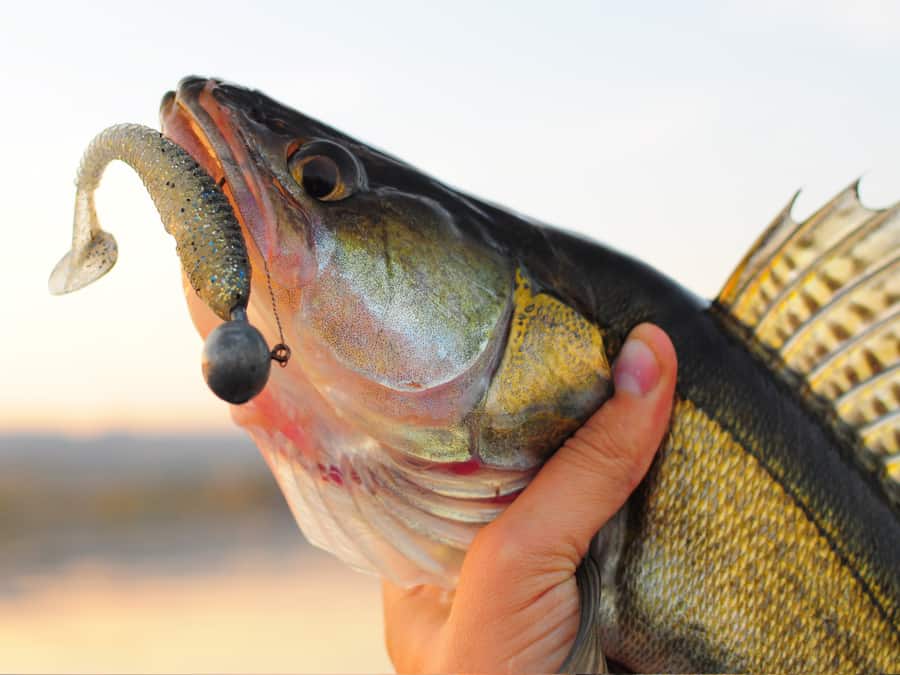
Table of Contents
Walleye Fishing in Arizona
Arizona offers surprisingly good opportunities for walleye fishing, particularly in its northern and central regions. While not as popular as some traditional walleye hotspots in the northern United States, Arizona’s diverse lakes like Lake Powell, Roosevelt Lake, and Show Low Lake provide good walleye opportunities for Arizona residents.
Unlike the cooler, often murkier waters of the northern walleye strongholds, many of Arizona’s walleye-friendly waters are clearer and warmer. In Arizona, walleye may be found deeper in the lakes during the hotter parts of the year to escape the heat, which is a different pattern compared to their behavior in northern lakes.
The biggest walleye I caught in Arizona was 6 lbs, 4 ounces at Fool Hollow Lake. Obviously not Moby Dick but that thing was strong. I caught it using a diving Rapala around a deep weed edge.
Click here to learn about walleye fishing in Utah.
Understanding Walleye in Arizona
In Arizona, walleyes mainly inhabit the cooler, deeper areas of lakes and reservoirs. They favor clear waters with plenty of cover like submerged structures or weed beds for ambushing prey. These fish thrive in lakes that have both sandy and rocky bottoms. These habitats are ideal for the small fish and insects walleyes feed on.
In Arizona, walleyes act differently each season. In spring, they swim to shallow waters to spawn, which is great for fishing. Summer’s heat pushes them to cool, deep waters. Unless you have a boat and a strategy, summer fishing can be tougher. In fall, they come back to the shallows as it cools off. But in winter, they go deep again.
Best Locations for Walleye Fishing in Arizona
Show Low Lake
Located in the White Mountains, this good-sized lake has clear water and really good walleye populations. It has some deep holes with water depths of 50+ common. Submerged structure to include timber, reefs, ledges, humps, and rock piles offer a nice variety of walleye-attracting features year-round.
This lake receives less pressure and attention than some of the more popular lakes in the state. Focus on deep weed lines and drop-offs as well as near the dam during the daytime. From evening until early morning, walleye will push shallower so inlets and bays can be good spots to fish. Minnows, shad, and leeches are present in the lake. Average walleye size will be 12-20 inches with some larger ones possible.
Fool Hollow Lake
This scenic lake located in the Apache-Sitgreaves National Forests near Show Low, Arizona offers very good walleye fishing. Expect most fish you catch to max out at 18 inches with some bigger fish over 20 inches present in the lake. The lake’s diverse habitat, which includes a mix of shallow and deep areas, submerged structures, and ample forage, creates an ideal environment for walleye.
Its relatively cooler waters, especially in deeper areas, are conducive to walleye growth. Fish around the dam and submerged deep structure during the daytime and transitional areas (where shallow meets deep water) in the morning and evenings.
Upper Lake Mary
Located near Flagstaff, this long, narrow lake offers good walleye fishing in deeper waters during the summer. This lake offers some of the biggest walleye in the state with averages up to 25 inches common. The lake’s large size, varying depth, and abundant forage create a conducive environment for walleye.
Its fluctuating water levels contribute to dynamic and challenging fishing. Focus on deeper holes to include drop-offs, ledges, and near the dam during the summer in the daylight hours. Feeder creeks and inflows can offer good fishing in spring and fall. These spots are especially good after snowmelt.
Lyman Lake
Located in northeastern Arizona, Lyman Lake stands out for its lack of motor size restrictions, making it a favorite for those looking to cover more area. Expect to catch a lot of walleye in the 12-18 inch range. The lake’s varying depth and abundant feed make it a reliable spot for catching walleyes.
The lake’s mixed habitats, including areas of deeper water and abundant structure, provides an excellent environment for walleye. Additionally, the lake’s lower fishing pressure compared to more popular lakes contributes to a healthy walleye population. Fish around deeper holes with structure to include humps, rock, and inside turns. Drop-offs are also a great feature for this lake.
Lake Powell
Only a small portion of Lake Powell extends into Arizona, but it can offer good walleye fishing to resident Arizonans. The numerous canyons and deep drop-offs offer a great environment for walleye.
The diverse structure, from steep rocky cliffs to sandy bottoms and submerged canyons, offers numerous fishing opportunities. The lake’s water level can fluctuate significantly, impacting fishing conditions and walleye behavior. Keeping updated with current water levels and conditions is crucial.
Spring and fall are generally the most productive seasons for walleye fishing in Lake Powell, with walleye moving into shallower waters for spawning in the spring and feeding actively in the fall. You can expect most walleye to be in the 15-25 inch range. Shad is the dominant bait source in the lake.
Roosevelt Lake (a Salt River Lake)
The largest of the Salt River Lakes has a robust walleye population. Its large size and varied habitat, including deep water areas and rocky structures, provide ideal conditions for walleye. Look for walleye in deeper waters, especially around rocky structures and drop-offs. The areas near the dam are very good during summer.
Apache Lake (a Salt River Lake)
This smaller Salt River Lake offers good scenery and less crowds than some of the other lakes. Walleye fishing can be good as the lake offers a nice mix of deeper and shallow water with deep structure and cover. Transitional zones where deep and shallow tightly meet (around ledges and drop-offs) will be your best bet.
Canyon Lake (a Salt River Lake)
Another small lake in the chain of Salt River Lakes, Canyon Lake offers nice walleye fishing due to its clear water, deep drop-offs, and varying habitats. Look for walleye in deeper spots like along canyon walls and rock pilings. Fish average 12-20 inches. It has a good reputation among walleye anglers for offering consistent fishing throughout much of the year.
Saguaro Lake (a Salt River Lake)
This is one of the most popular (& fished) lakes in the state. My best recommendation would be to fish on a workday or under rainy conditions in the shoulder seasons of spring and fall. Weekends in summer can be a real zoo. It has some awesome structure in medium and deeper water perfect for growing big walleye. Focus on deeper areas near the dam and main lake drop-offs.
Colorado River
While primarily known for other species, some stretches of the Colorado River, particularly where it forms reservoirs like Lake Havasu, offer good walleye fishing.
Salt River
Before it forms the Salt River Lakes (Roosevelt, Apache, Canyon, and Saguaro), the Salt River has good walleye populations, especially in areas with slower-moving water.
Hidden Gems
Chevelon Canyon Lake
This remote and scenic reservoir is located in northern Arizona. Most known for trout fishing, it offers some really nice walleye opportunities. The lake is deep and clear so use long fluorocarbon line and smaller, more realistic baits. Access will be your biggest issue as a high-clearance vehicle is needed to reach the lake. Fishing pressure is kept in-check by these limitations.
Blue Ridge Reservoir (CC Cragin Reservoir)
Located near the Mogollon Rim area, this narrow reservoir offers a good shot at walleye. Like Chevelon Canyon Lake, it offers cool, clear water so spool up some good fluorocarbon. Focus on the deeper holes during the day and shallower points and weed edges in the evening and night.
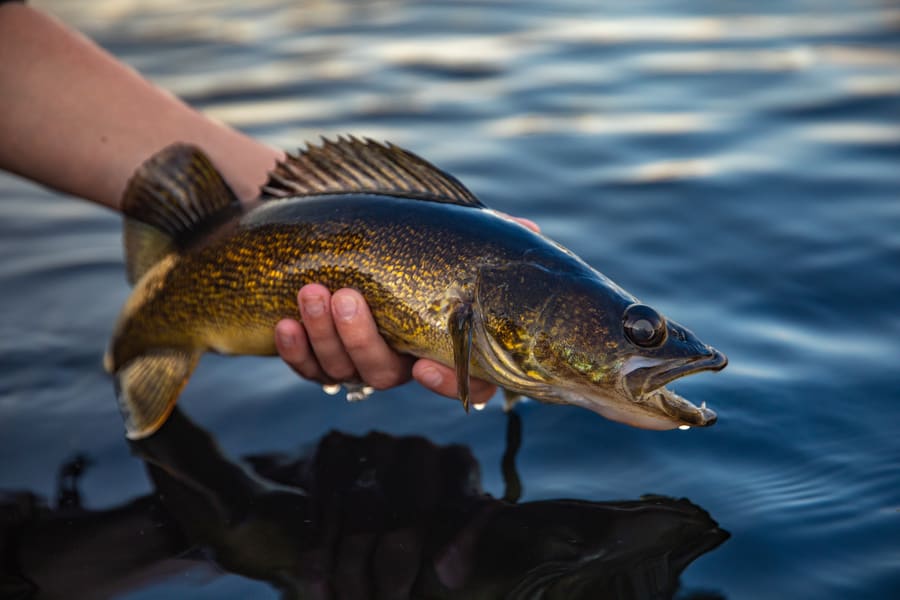
Bear Canyon Lake
This small, deep lake located in the Apache-Stigreaves National Forests has a small but healthy population of walleye. Accessibility issues limits the amount of fishing pressure. This can be a very interesting option for some nice walleye.
Knoll Lake
Located along the Mogollon Rim, this secluded lake is known for good populations of walleye and trout. Focus on deeper holes and main lake points during the warmer, summer months.
Ashurst Lake
Located a drive southeast of Flagstaff, this shallow lake does have some good walleye numbers. This lake experiences some strong winds so focus on the wind-blown sides of the lake where baitfish and walleye will congregate along deep weed edges and reefs. It’s a nice lake to try for some less pressured walleye.
Woods Canyon Lake
While mostly known for good trout fishing, it does hold a robust population of walleye. Located along the Mogollon Rim, this lake offers cool, deeper water. It offers great accessibility which can result in a lot of other boaters and people. But the fishing for trout and walleye can be quite good.
The Mogollon Rim is a very beautiful area. Just be aware it can get very busy during the summer and fall during the weekend with its proximity to Phoenix and Flagstaff. I recommend fishing in winter or early spring. Another great way to beat the crowds is fish mid-week rather than on weekends.
Conservation Efforts for Walleye Populations
Stocking Programs: The Arizona Game and Fish Department conduct stocking programs to maintain or enhance walleye populations in certain lakes and rivers.
Habitat Conservation: Efforts are made to conserve and improve habitats critical for walleye, including initiatives to maintain water quality and preserve aquatic ecosystems.
Research and Monitoring: Ongoing research and monitoring of walleye populations help inform management decisions and conservation strategies.
Be sure to reference the Arizona Game & Fish Department website for information about walleye management as well as to learn about fishing regulations.
Best Walleye Baits
Table: Best Walleye Baits for Arizona
| Lure/Bait Type | Recommended Colors | Recommended Sizes | Ideal Conditions/Notes |
|---|---|---|---|
| Jigs | Chartreuse, White, Orange | 1/8 to 3/8 oz | Effective year-round; adjust size for depth and current. |
| Crankbaits | Silver, Gold, Natural Perch | 3 to 6 inches | Great for trolling; mimic natural forage in lakes and rivers. |
| Spinnerbaits | White, Green, Yellow | 1/4 to 1/2 oz | Work well in murky water; use in and around weed beds and structures. |
| Soft Plastic Swimbaits | Silver, Gray, Blue | 4 to 6 inches | Mimic baitfish; ideal for clear water and night fishing. |
| Minnows (Live Bait) | Natural | 2 to 4 inches | Effective all year; use with a jig head or live bait rig. |
| Nightcrawlers (Live Bait) | Natural | 4 to 6 inches | Popular in warmer months; use with spinner rigs or bottom bouncers. |
| Leeches (Live Bait) | Natural | Medium to Large | Best in late spring and summer; use on a simple hook or jig. |
| Spoons | Silver, Fluorescent Colors | 2 to 5 inches | Good for deep water jigging and casting in rivers. |
Most Popular Walleye Techniques in Arizona
- Trolling: Using planer boards or downriggers to cover various depths and areas, especially in larger lakes like Lake Powell.
- Jigging: A favored method in both lakes and rivers, using jigs tipped with live bait or soft plastics to target walleye in deeper waters or near structures.
- Live Bait Rigging: Drifting or slow-trolling with live bait such as minnows, nightcrawlers, or leeches, especially effective in reservoirs like Roosevelt and Apache Lakes.
- Deep Water Fishing: In Arizona’s warmer climate, walleye often retreat to deeper, cooler waters, especially in summer. Techniques like deep-water trolling or vertical jigging can be very effective.
- Night Fishing: Due to the hot daytime temperatures, night fishing can be particularly productive in Arizona. Walleye are more active during cooler nighttime hours.
- Use of Lighted or UV Baits: In Arizona’s clear and often deep waters, lighted or glowing lures and jigs can be especially attractive to walleye, particularly when fishing at night or in deeper waters.
- Seasonal Adaptation: Adjust your techniques with the seasons. In spring, focus on shallower areas for spawning walleye, while in summer and fall, transition to deeper waters.
- Leveraging Local Forage: Tailor your bait selection to mimic local forage fish that walleye prey on in Arizona waters, such as shad or small sunfish.
- Utilizing River Currents: In river settings, like parts of the Colorado River, use the current to your advantage. Position baits in eddies or slower-moving water where walleye may be waiting to ambush prey.
Frequently Asked Questions
What is the state record for Walleye in Arizona and where was it caught?
The state record for walleye in Arizona is a 16-pound, 2-ounce fish, caught at Show Low Lake.
What is the average, big, and trophy size of Walleye in the state of Arizona?
In Arizona, the average size of Walleye is about 2-3 pounds, big Walleye are typically around 5-6 pounds, and trophy-size Walleye can exceed 8 pounds.
Is a special license required for Walleye fishing in Arizona?
A general Arizona fishing license is required for Walleye fishing, with no special additional license needed. Please refer all licensing and regulations questions to the Arizona Game & Fish Department as well as your local licensed bait shop operator.
